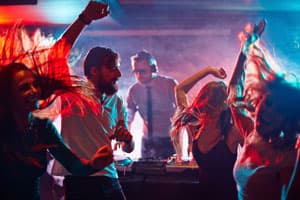
Ecstasy Addiction: Signs, Dangers & Treatment Options
What Is Ecstasy?
Ecstasy, which is also commonly referred as Beans, X, Adam, and Disco Biscuit, was initially popular as a “club drug” at all-night dance parties, though it now affects a broader range of people.2 If you think you have a problem with ecstasy use or addiction, you’re not alone. This page will provide more insight into ecstasy as a drug, its addictive nature, its effects, signs of ecstasy use, and what treatment options are available.

Signs & Symptoms of Ecstasy Addiction
Some people who use ecstasy do not believe it is physically addictive, but do believe it is psychologically addictive.4 The hallmark of addiction is the continued use of a substance despite experiencing negative health, occupational, and social consequences as a result. People who use ecstasy can develop a pattern of use that becomes problematic enough to interfere with their lives. This can lead to the potential development of hallucinogen use disorder.
Some, but not all, signs that a hallucinogen use disorder may be occurring include:5
- Taking more ecstasy than intended or taking it more often than intended.
- Spending a great deal of time buying or using ecstasy.
- Suffering serious problems at work or school due to ecstasy use.
- Ignoring personal obligations in favor of using ecstasy.
- Taking increasing amounts of ecstasy to overcome tolerance (e.g., feeling decreasing effects with the same dose).
- Failing in attempts to stop using ecstasy.
- Using ecstasy when doing so can be hazardous, such as when operating machinery or driving.
Risks & Dangers of Ecstasy Use
While ecstasy can initiate any one of these effects with just a single use, many individuals raise their risk of experiencing adverse health effects with repeated “trips.” Here are some of the health effects that may be experienced when people use ecstasy frequently:1
- Increased risk of contracting sexually transmitted diseases, including hepatitis and HIV/AIDS
- Hyperthermia (e.g, dangerously high body temperature) as a result of severe dehydration
- Spike in body temperature consuming taking high doses, which can affect the body’s ability to regulate temperature, occasionally resulting in liver, kidney, or heart failure, or even death
- Severe depression or self-harm resulting from a “crash” after drug use
- Brain-oriented problems, including memory lapses, stroke, and brain hemorrhages
- Migraine headaches, possibly resulting from dehydration, exhaustion, and ocular migraines triggered by flashing or strobe lights
- Cardiac issues including increased blood pressure, irregular heartbeat, and severe chest pains
- Kidney and liver problems, even possibly failure of one or both organs
- Circulatory problems due to reduced blood supply to body tissue
- Dental problems including severe dental decay and gum disease
Rehab & Treatment for Ecstasy Addiction
While it can be difficult to overcome an addiction to ecstasy, it can be achieved. There is no one specific type of facility or ecstasy rehab program that is suitable for everyone.6 Ecstasy addiction treatment is designed to address not just your substance use, but all of the ways in which it has negatively affected your life, which may include your physical health, your mental health, and your ability to work or attend school.6,7
There are a variety of treatment options available, including private facilities, state-run treatment facilities, and local treatment programs. There are also support groups that can help you as you work toward becoming sober and maintaining that sobriety, such as Narcotics Anonymous (NA), which is rooted in the 12-Step philosophy.
Ecstasy treatment programs typically provide an individualized treatment plan that is tailored to your unique needs. They often use a combination of different techniques to address your ecstasy addiction and how it has affected you.6,8 These can include:6,8
- Residential addiction treatment, where you live at a facility, and receive care and/or support around the clock.
- Inpatient addiction treatment typically involves a shorter stay at a facility with around-the-clock monitoring and care, intense group therapy, and individual counseling.
- Outpatient addiction treatment offers less intensive group and individual counseling while you live at home. This type of care allows you to work, attend school, and participate in daily life while attending treatment.
- Behavioral therapy in group, individual, and/or family settings is highly effective for treating addiction to ecstasy and other substances.
- Treatment for co-occurring disorders, which addresses mental health disorders at the same time as a substance use disorder, is generally more effective than treating these issues separately.
For more information about ecstasy use and addiction treatment, contact one of our team of rehab admissions navigators at for the information and support you are looking for as you look for ecstasy abuse treatment.
There are various treatment programs and strategies available for ecstasy addiction, so don’t give up if the first program you check out doesn’t meet your individual needs. To learn more about amphetamine addiction treatment, click here.